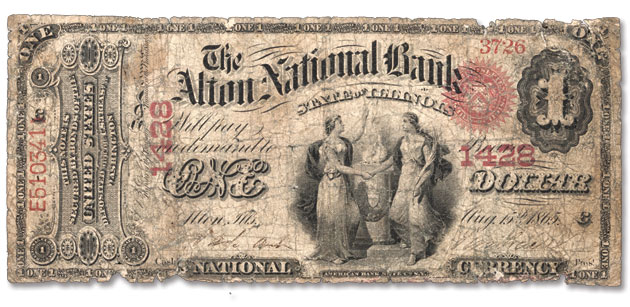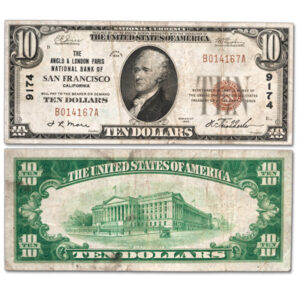A deep dive into the history of National Bank Notes
And should you reference Charter Periods?
Within the collecting world, there are several niches that individuals can get into. Quarters, for one – a trend that really kicked off with the Statehood quarter series and National Park quarters. Ancient coins are another, which is one of my favorites (there’s some serious intrigue and mystery held within those coins!).
Today, I’m taking a look into a very specific area of paper money – another collecting niche that I’m particularly fond of. Let’s dive into the history of National Bank Notes!

Let’s start at the beginning
The beginnings of National Bank Notes date back to 1863 – specifically, February 25. That’s the day that President Abraham Lincoln signed The National Bank Act (also known as The National Currency Act).
In addition to establishing the Office of the Comptroller of the Currency (which is still in place today), the National Bank Act also created a uniform currency for America and a framework of nationally chartered banks. But why was this important?
The why behind the National Bank Act
A note about Charter Periods
Occasionally, National Bank Notes are categorized by Charter Periods (1st Charter, 2nd Charter and 3rd Charter). The concept of Charter Periods came out around the turn of the 20th century, and has since been debunked – most notably by paper money scholar Peter Huntoon. (If you’re able to get ahold of the November 2012 issue of Bank Note Reporter, he has a great article on the topic!) In Mr. Huntoon’s estimation, the more accurate way to describe the releases of National Bank Notes is by Series:
- Original Series/Series of 1875
- Series of 1882
- Series of 1902
Of course, there are subsets within each series (Date Backs, Value Backs, etc)… but that may be a topic for another day!
First and foremost – wars are expensive, and Lincoln needed a way to bankroll efforts for the Civil War. In order for National Banks to be created, they would need to secure financing. This was accomplished by paying for interest-bearing bonds… which resulted in a cash flow into the U.S. Treasury. War funding achieved.
Another benefit to the National Bank Act was increased public confidence in the security of America’s paper money. Prior to 1861, U.S. paper money was issued by private banks that had been issued state charters. Sadly, there was a hole in the system that took a toll on depositors. If the bank loaned enough money to debtors that weren’t able to repay their loans, the bank would go broke and have no choice but to close its doors.
For those who held the notes issued by these private banks, the results were potentially disastrous. They now held paper money (not “hard money”) that was worthless. This risk was eliminated with the advent of government-backed paper money! The first government-backed notes debuted in 1861 (Demand Notes) and 1862 (Legal Tender Notes). Unlike National Bank Notes, though, Demand Notes and Legal Tender Notes were not issued by individual banks.
A good run
Ultimately, National Bank Notes were released for 72 years, from 1863-1935 in denominations from $1 through $1,000. One benefit of National Bank Notes was that the designs for each denomination were uniform. A $1 note from a bank in North Carolina would look nearly identical to a $1 note from a bank in Vermont. The only noticeable differences would be the bank’s name, location, and charter numbers.

National Bank Notes even saw (and survived) the changeover from large-size paper money to small-size in 1929. Both Type I (Charter Numbers printed in heavy black ink twice on the face) and Type II (same as Type I, with the addition of the Charter Numbers printed twice in brown ink near the serial numbers) Nationals were released under Series 1929.
A “note” worthy end
Of course, all things eventually run their natural course. In 1935, the Treasury retired the bonds that were used as security to back National Bank Notes. This brought the era of National Bank Notes to an end.
Do you collect National Bank Notes – or paper money in general? I’d love to hear about your favorite notes in the comments below. And if you’d enjoy more dives into different areas of paper money history, let me know what you’d like to read about. You might see it in a future article!



